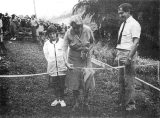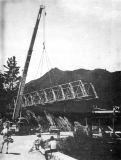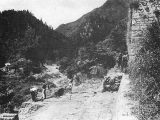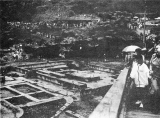Ohinemuri Regional History Journal 29, October 1985
By Nancy Swarbrick
On Saturday 2 March of this year, the Crown Battery site at Karangahake was the scene of unusual activity, as a crowd of over 600 people gathered to take part in the opening of Stage I of the Karangahake Gorge Historic Walkway. The Kerepehi Brass Band provided background music while official guests and members of the public assembled near the concrete steps above the old stamper floor at 1.30 pm. The rain which had been threatening all day finally arrived about this time. However, the ceremony proceeded, and addresses were given by representatives of the Department of Lands and Survey, the New Zealand Railways Corporation and the Karangahake Historic Walkway Promotion Committee. More than one speaker reminded the audience that the Walkway track was built on the formation of the historic Paeroa-Waihi railway line, which years ago passed through one of the richest gold mining areas in New Zealand.
As the speeches finished, the sun came out for a moment, and Lady Blundell, wife of the late Sir Denis Blundell who was patron of the Promotion Committee, stepped forward to declare the Walkway open. After cutting the gold ribbon stretched across the track, Lady Blundell and members of her family led the large crowd down through the remains of the Crown Battery, across the footbridge spanning State Highway 2, and into the 1086 metre-long railway tunnel. Once again, rain fell steadily as scattered groups of people made their way from the eastern portal of the tunnel to the end of Stage I. By the time Owharoa Falls was reached, the weather had cleared, and there was an opportunity for everyone to stop and rest before going home. So ended a day which was the culmination of nearly eight years planning and work.
It is an almost uncanny coincidence that the opening of the Walkway took place on the 85th anniversary of a ceremony to celebrate the start of construction for the Paeroa-Waihi railway. On Friday 2 March 1900, a crowd of Ohinemuri residents gathered near the Crown Battery to witness the Minister for Railways, the Hon. J G Ward, turn the first sod of the long-awaited branch line. The official party included the Premier, the Right Hon. R J Seddon; the MHR for Ohinemuri, Mr Jackson Palmer; and the chairman and councillors of the Ohinemuri County Council. Like their counterparts of 85 years later, the speakers were quick to point out the benefits of the new development for the local community.1
Looking back, it is easy to see other parallels between the building of the railway and the development of the Walkway. Readers of the Ohinemuri Regional History Journal will be aware of the long battle which was waged to obtain a railway. The line, when it was finally approved, took five years to build, and during that time there were many delays and a few disasters. The expense, too, was considerable.2 The story of the Walkway is similar in many respects.
By 1971, it was common knowledge that the Paeroa-Apata section of the East Coast Main Trunk line was to be closed as soon as the Kaimai Tunnel had been completed. During this year, it was suggested that the formation of the line be used as a walkway. At the time the concept of walkways was relatively new - the New Zealand Walkways Act had been passed only two years before, in 1975. The Act aimed to establish walking tracks across public and private land so that the people of New Zealand could have safe foot access to the countryside for recreational purposes. It was to be administered at a national level by the New Zealand Walkway Commission, and locally by 12 District Walkway Committees. The Department of Lands and Survey accepted responsibility for the construction and day-to-day maintenance of most walkways. So it was at the request of the South Auckland District Walkway Committee that Lands and Survey Reserves Rangers first inspected the railway line in November 1977.
The scenic and historic attractions of the Karangahake Gorge were immediately recognised, and approaches were made to New Zealand Railways during 1978. However, there was continuing argument over the fate of the railway line. Its closure was seen as an economic blow to the Ohinemuri region, especially Waihi, and controversy continued even after the regular train service ceased in September 1978. For this reason there was a delay in lifting the track.
Planning for a walkway continued, and in April 1979, a proposal to use the railway formation through the Karangahake Gorge was made to the Walkway Commission. The Commission approved the walkway concept in principle, subject to further planning. Meanwhile, there were moves locally to set up a tourist steam train, and by late 1980 the Goldfields Steam Train Society had been formed. Consequently, New Zealand Railways agreed to divide the railway land between the Steam Train Society, who were given the section of track between Waihi and Waikino, and the Department of Lands and Survey, who received the rest of the line from Waikino to Paeroa. In the latter case, control was not to be formally handed over until the track was lifted.
Track removal began in March 1981 and continued throughout the year. As part of the cleaning-up operations, some bridge spans and decking were removed. At this stage the sale by tender of the picturesque railway bridge at the eastern portal of the tunnel was suggested, but in the end it was kept for Walkway use. It was not possible, however, to retain all of the combined road/rail bridge over the Ohinemuri River and State Highway 2 at the west portal of the tunnel. The railway level of the bridge was too low to allow adequate clearance for large trucks passing along the road beneath, so this section was demolished, leaving only the vehicle bridge across the river.
Finally, on 1 January 1982, the administrative control of the railway land passed to the Department of Lands and Survey, and preparations for the Walkway began in earnest. First, some of the land towards Paeroa which had originally been taken by the Government for railway purposes had to be sold back to the owners at valuation, according to agreement. Meetings were arranged with local property owners to inform them of plans for a walkway.
In late 1982 it was decided to employ someone to find out more about the gold mining and railway history of the area, for the information of staff involved in the project. I was given the job of doing this research. Although I had travelled through the Gorge en route to Waihi Beach many times, I knew very little about the fascinating history of the area. The articles of the Ohinemuri Regional History Journal were my first source of information, and they provided an insight into the human side of the past which was not evident in the official documents I later used. During the course of seven months, I produced a preliminary report summarising the main aspects of local history. I also gathered together some photographs of the Karangahake batteries and the railway.
While the initial research was being completed, a detailed case for the Walkway was put together. The route itself was divided into stages for the purpose of construction, which was expected to take six years. Stage I was to follow the old line from the Crown Battery at Karangahake via the railway tunnel to Owharoa Falls. Stage II was to continue along to the Victoria Battery site and across a railway bridge to the Waikino station site on the other side of the Ohinemuri River. Stage III, also known as the Waitawheta Loop Track, was to commence at the eastern portal of the tunnel and follow the true left bank of the Ohinemuri River past the Woodstock and Talisman battery foundations and back to the Crown Battery site. A further stage, linking Karangahake with Paeroa, was seen as a possibility for the distant future. In view of a growing awareness of the needs of disabled people, it was suggested that Stages I, II and possibly III be made accessible to wheelchairs.
The historical significance of the Karangahake Gorge was given stronger emphasis in this proposal. It was planned to interpret the history of the area for visitors to the Walkway, through a system of signs, wayside exhibits and publications. After Stage III of the track development had been completed, an Interpretation Centre was to be built on the site of the former Karangahake railway station. This Centre would house a general information service, and displays of artifacts and photographs relating to the gold mining and railway period.
From the construction angle alone, the project was clearly very ambitious. Several major bridges had to be built, and considerable work was needed to bring the track surface up to wheelchair standard. Then there was the cost - an estimated $385,800 excluding labour.
Fortunately, support for the Walkway was gathering momentum. It was seen to provide an important physical link between the Paeroa Historical Maritime Park and the Waikino-Waihi steam train venture. Also, the location of the Walkway track near to State Highway 2 suggested that it would attract a large number of visitors. The Walkway Commission was impressed by this potential, and in July 1983, gave formal approval to the project.
Meeting the cost of development was a major challenge. It is interesting here to recall the method of financing the Paeroa-Waihi railway. According to official records, yearly grants alone were insufficient to cover the cost of building the line, and in 1903 the Waihi Gold Mining Company lent the Government 75,000 pounds so that work could be completed.3 The approach to Walkway funding was similar in that private interests were to he involved. Fifteen thousand dollars were granted for the 1983-84 year, in the expectation that more money could be obtained from business firms. Thus the Karangahake Historic Walkway Promotion Committee was formed, with the aim of acquiring sponsorship for the Walkway.
Construction began during August 1983. Local labour was employed under Labour Department and Department of Lands and Survey subsidised temporary work schemes: PEP (Project Employment Project) and SES (Special Employment Scheme). Lands and Survey staff, notably Senior Ranger John Greenwood and Gerard Besamusca, were responsible for supervision. During the next twelve months various teams did an enormous amount of work in preparing Stage I. The eastern portal railway bridge was repaired, and wooden decking and handrails were put in place. Both portals of the tunnel were cleaned by a water-blasting process to reveal the attractive brickwork underneath the soot. The Crown Battery site was cleared of scrub and debris, and even some Karangahake residents were surprised at the extent of the stone and concrete foundations which were uncovered. At the same time, work on the track continued. A number of culverts and drains were built, and loads of Waikino sand were brought in to spread on the foundation of railway ballast.
As work progressed, a landscape plan discussing aspects of design and planting work for the Walkway was drawn up. Much of the old railway line had become overgrown and an intensive weed control programme was needed. In addition, some sections of the line were unsheltered and visually uninteresting. It was decided, therefore, to plant areas adjacent to the Walkway in exotic and native trees. To assist with this, a grant of $6,000 was obtained from the Beautiful New Zealand scheme in May 1984.
In June, I began further work for Stage I interpretation. This involved researching and writing the signs to be positioned along the Walkway. We arranged to have the information reproduced on gold-coloured photometal plates, for maximum effect and durability. First, texts and illustrations were sent to the Lands and Survey Visual Production Unit at Nelson, where the artwork was completed. The designs came back to Hamilton, where they were checked, and if necessary altered, and then finally they were sent to Auckland for photometal processing. The whole procedure was to take about eight months.
Although Stage I was well advanced by the middle of 1984, finance was becoming more of a problem. Some substantial donations had been received from business firms, but not as many as were hoped for originally. A major expense still to he met was the building of a footbridge over State Highway 2 at the west portal of the tunnel. The estimated cost of the structure alone was $23,000, an additional $22,000 being required for the ramp and decking. This was far beyond the amount of money which could be allocated by the Walkway Commission. The outlook seemed hopeless, but in August there was a sudden stroke of luck. More than 120 metres of Callendar Hamilton footbridge components, which had been used on the Turangi power project, came up for sale. This giant meccano set, as it was called, was bought for a mere $5,000 and transported to Karangahake for a further $2,000. It turned out that the components were sufficient for the bridge at the west portal and also the bridges across the Ohinemuri River at Waikino and the Waitawheta River opposite Karangahake. The overall saving meant that Stage I could be completed to schedule, and so the opening date of 2 March 1985 was set.
Additional donations helped the project at this crucial time. In November the Waihi Gold Company gave $3,000 towards the cost of the west portal bridge, and in December Dunlop NZ Ltd donated a utility vehicle for the use of construction staff. During February Philips NZ Ltd presented a cheque for $5,000 to cover the cost of lighting in the tunnel.
As the opening date drew nearer, preparations seemed to be well in hand. Construction of the ramp up to the west portal bridge was under way, and the lower deck of the bridge itself was being sand-blasted and painted by a firm under contract to the Ohinemuri County Council. Work on the track was nearly complete.
Then on Sunday 17 February, heavy rain fell over the whole of the Ohinemuri region. Thames, Paeroa and Te Aroha were hit by devastating floods. The Karangahake Gorge was not as greatly affected, but damage to the Walkway was sufficient to put the opening in doubt. There were numerous slips along the track between the eastern portal of the tunnel and Owharoa Falls, and the scaffolding which was being used in the painting of the west portal bridge had been swept away down the Ohinemuri River. Even if the debris could be cleared in time, it was not certain that the weather would hold long enough for the Callendar Hamilton bridge to be put in place over State Highway 2. In spite of this, it was decided to go ahead and attempt to open the Walkway on time.
Repairs began immediately, and Lands and Survey staff were sent from Hamilton to assist. SES gangs spent long hours digging through slips and tidying and re-shaping the track. On Monday 25 February, in perfect weather, the 30 metre, 12 tonne pre-fabricated footbridge was transported from Mackaytown to the west entrance of the tunnel. Traffic was held up briefly as a crane lifted the structure into position. Once this link was in place, the opening of the Walkway was assured, but final preparations were hampered by more wet weather. In fact, work continued up until the morning of Saturday 2 March. The track may have been a little rough in places on the opening day, but thanks to this extra effort it was at least usable.
Since the opening many people have walked along Stage I. On Queen's Birthday weekend, for instance, approximately 400 people were counted on the Walkway each day. This level of use justifies the high expenditure and suggests the importance of continuing with the construction of Stages II and III.
On both of these stages there are historical features of great interest. Stage II passes through the Victoria Battery site, where once gold-bearing quartz from the Waihi Gold Mining Company's mine was crushed and treated. Although the land has been worked over for gold residues many times since the closure of the battery, extensive stone and concrete foundations have been left standing. Stage III follows the route of a water pipe-line to the remains of the Woodstock and Talisman batteries at the confluence of the Waitawheta and Ohinemuri Rivers. The foundations are at present obscured by bush, but when uncovered, they should be quite impressive.
However, work on Stages II and III may be delayed if more money is not forthcoming. There is a limit to how much the Walkway Commission can expend, and to a certain extent, further developments are dependent on the generosity of business groups who can recognise the importance of the project in providing recreational and employment opportunities. When considering the future, it is helpful to look to the past. The Paeroa-Waihi railway was built slowly, and against great odds, but it was eventually completed because local people continued to press for it. Similarly, if there is consistently high public support for the Walkway, construction should proceed in the next few years.
* * *
|
1 |
Information from: |
|
|
Auckland Weekly News |
Friday 2 March 1900 pp 26, 29 Friday 9 March 1900 p 12 |
|
|
Waikato Argus |
Thursday 1 March 1900 |
|
|
New Zealand Herald |
Saturday 3 March 1900 |
|
|
New Zealand Mines Record |
No 8, 16 March 1900, p 315 |
|
|
2 |
Ohinemuri Regional History Journal articles including: |
|
|
R Lowry: "The Ohinemuri Railway Era" vol 5, no 2, October 1968 |
||
|
A C Bellamy: "Paeroa-Waihi Railway 1897—1978" July 1979 |
||
|
L Mathieson: "From Karangahake to Kaimai (1905—1978)" July 1979 |
||
|
3 |
Appendices to the Journals of the House of Representatives |
1903 D1 pp iii—iv |
|
Auckland Weekly News |
30 July 1903 p 27 |
|
|
29 October 1903 p 26 |
||
|
New Zealand Statutes 1903 |
p 254: An Act to provide for the Speedy Construction of a Railway from Paeroa to Waihi (20th November 1903) |
|




